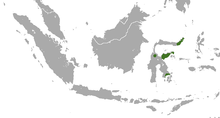Macrogalidia
| Sulawesi palm civet | |
|---|---|
| Scientific classification | |
| Kingdom: | Animalia |
| Phylum: | Chordata |
| Class: | Mammalia |
| Order: | Carnivora |
| Family: | Viverridae |
| Subfamily: | Paradoxurinae |
| Genus: |
Macrogalidia Schwartz, 1910 |
| Species: | M. musschenbroekii |
| Binomial name | |
|
Macrogalidia musschenbroekii (Schlegel, 1877) |
|
 |
|
| Sulawesi palm civet range | |
The Sulawesi palm civet (Macrogalidia musschenbroekii), also known as Sulawesi civet, musang and brown palm civet is a little-known palm civet endemic to Sulawesi. It is listed as Vulnerable by IUCN due to population decline estimated to be more than 30% over the last three generations (suspected to be 15 years) inferred from habitat destruction and degradation.
Macrogalidia is a monospecific genus.
The Sulawesi civet has a light brownish-chestnut coloured soft and short coat with numerous light hairs intermixed. The underparts vary from fulvous to white; the breast is rufescent. There is a pair of indistinct longitudinal stripes and some faint spots on the hinder part of the back. The whiskers are mixed brown and white. The tail is marked with alternating rings of dark and pale brown, which are indistinct on the under surface, and disappear towards the dark tip. The length of head and body is about 35 in (89 cm) with a 25 in (64 cm) long tail. The skull with the bony palate is much produced backwards, but otherwise resembles that of Paradoxurus hermaphroditus. The teeth differ from those of all the Paradoxurus species in that the two cheek-series run nearly parallel, in place of being widely diververgent posteriorly.
The Sulawesi palm civet is a fairly large palm civet weighing about 3.8–6 kg (8.4–13.2 lb).
Sulawesi palm civets have been recorded in lowland forest, lower and upper montane forest, grasslands and near farms. They appear to be more common in forests than in agricultural areas. Although they appear to be generalists that can probably tolerate some degree of disturbed habitat, there is no good evidence that populations can survive independent of tall forest.
Sulawesi palm civets are omnivorous and feed on small mammals, fruit and grass. They occasionally take birds and farm animals. Their home range is estimated at about 150 ha (0.58 sq mi).
...
Wikipedia

